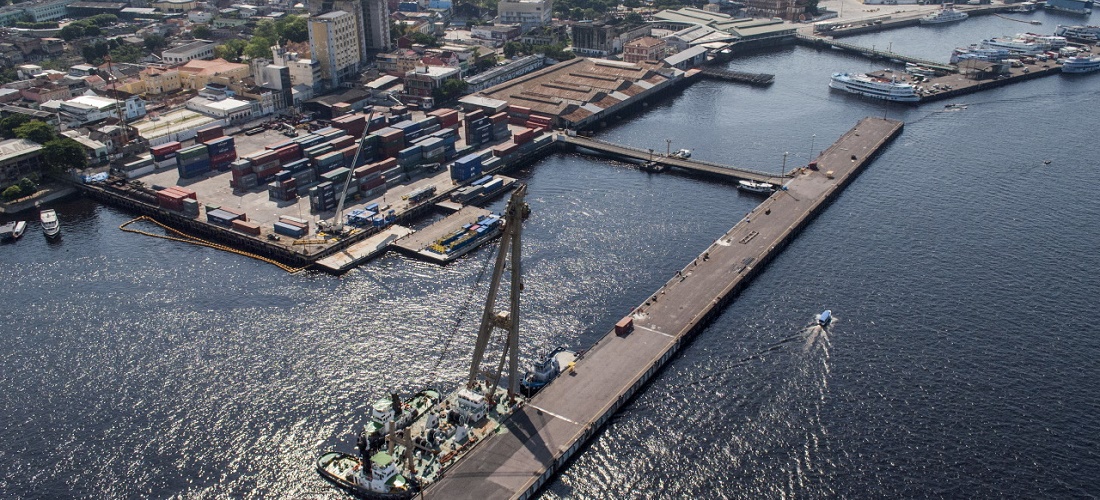
Drought in Northern Brazil raises alert for Port of Santos operations
Jul, 31, 2024 Posted by Gabriel MalheirosWeek 202431
Coastal shipping and multimodal logistics companies are concerned about the impacts of the drought in Northern Brazil on the Port of Santos, especially regarding fixed maritime transport lines between the Santos port complex and Manaus.
Based on information from Brazil’s National Water Agency (ANA) and early analyses of regional data, there are strong indications that navigation restrictions will return during the dry season between September 2024 and early 2025.
This projection is based on last year’s events. “Although the logistical problem in Manaus and the region became more evident during the drought, it had repercussions throughout Brazil. Santos was severely impacted, as it stopped receiving products from the Manaus Free Trade Zone, which supplies retail consumption, especially large department stores,” recalls Luis Fernando Resano, executive director of the Brazilian Association of Cabotage Shipowners (ABAC).
Resano also noted that during the drought, some cargo was prevented from leaving the port as no one knew whether it could reach Manus. “Since Santos is the primary port for cabotage container movement, it was severely impacted in terms of inbound and outbound operations,” he says.
The chart below uses DataLiner data to compare long-haul container imports and exports at the Port of Santos between January 2021 and June 2024.
Santos Container Movement | Jan 2021 – Jun 2024 | TEU
Source: DataLiner (click here to request a demo)
Company Responses
Marcus Voloch, Vice President of Shipping at Log-In Logística Integrada, reports that the company offers two regular weekly services connecting Manaus to the Port of Santos. He recalls that the 2023 drought was longer and more severe than previous years, resulting in an unusual suspension of larger vessels.
“Depending on the severity and duration of the drought, reduced water levels impede navigation in the region, forcing shipping services to reduce freight volumes in order to safely navigate to Manaus. This results in tighter restrictions on product distribution in the Southeast Region and cargo supply from other Brazilian ports, such as Santos, to the North Region,” he says.
According to Gustavo Paschoa, CEO of Norcoast, a coastal shipping company, climate prediction models indicate that the drought is caused by global warming rather than El Niño, adding concerns. “This change suggests that more severe droughts in the North Region will become the norm. As a result, delays and cargo congestion will disperse to additional ports. He predicts that route redirection will cause congestion in Santos.
In a statement, Maersk and Aliança informed their customers of the situation and urged them to expedite their cargo transportation to the region.
Ministry of Ports Downplays Situation
The Ministry of Ports and Airports (MPor) assures there are no foreseeable impacts on coastal shipping between Santos and Manaus. Actions have been taken, particularly for the Manaus-Itacoatiara stretch. The National Department of Transport Infrastructure (DNIT) reported that, to date, it has not received notifications about transportation problems in the mentioned stretch.
DNIT highlights that in June, together with the Ministry of Transport and MPor, they launched bidding notices for dredging services to ensure the navigability of the Amazon and Solimões rivers during the dry season. The planned investment is estimated at around R$500 million, earmarked for five years.
Luis Fernando Resano of ABAC states that the ideal time for dredging is the beginning of August. ABAC has been working with MPor, the Brazilian Navy, and DNIT to form a working group to plan ahead and address a potential drought.
“The private port sector is also creating alternatives to mitigate a possible drought, including installing a floating dock in Itacoatiara and increasing operating capacity in Vila do Conde, where the final leg of the cargo would be carried out by barges, despite the increase in transit time and costs,” adds Resano.
Potential Nationwide Impact
The drought’s problems may extend nationwide. “The impact is predictable since Manaus is the second largest container port in coastal shipping. If we cannot reach this port or have reduced operational capacity, the Free Trade Zone will struggle to ship local products, and the region will face supply shortages,” Resano states.
The Manaus Free Trade Zone manufactures various products, including household appliances, vehicles, motorcycles, TVs, cell phones, bicycles, air conditioning units, and computers, which supply the Southeast market. Many of these goods are transported via coastal shipping from Manaus to the Port of Santos for distribution in the Southeast Region. Likewise, inputs destined for industries and the North Region’s population are sent via the Santos port complex.
Source: A Tribuna
Click here to access the original text: https://www.atribuna.com.br/noticias/portomar/seca-nos-rios-em-manaus-preocupa-empresas-por-impactos-no-porto-de-santos-1.428637
-
Trade Regulations
Oct, 04, 2021
0
New inspection rules delay animal-origin food imports
-
DW 2019 EN
Jul, 08, 2019
0
DatamarWeek 09 July 2019
-
Meat
Sep, 08, 2022
0
Brazil: beef exports hit all-time record
-
Shipping
Nov, 03, 2021
0
Cabotage shipping resumes growth



